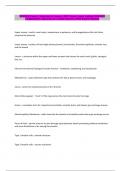NUR3196 Exam 3 | Questions & Answers (100 %Score) Latest Updated 2024/2025
Comprehensive Questions A+ Graded Answers | With Expert Solutions
Upper airway - mouth, nasal cavity, nasopharynx, oropharynx, and laryngopharynx (the last three
comprise the pharynx)
Lower airway - trachea, left and right primary bronchi, bronchioles, bronchial capillaries, alveolar sacs,
and the alveoli
Larynx - a structure within the upper and lower airways that houses the vocal cords, glottis, laryngeal
box, etc.
Internal and external laryngeal muscles function - ventilation, swallowing, and vocalization
Mediastinum - space between lungs that contains the heart, great vessels, and esophagus
Carina - where the trachea branches into 2 bronchi
Hilum (Hila singular) - "roots" of the lungs where the main bronchi enter the lungs
Acinus - cumulative term for respiratory bronchioles, alveolar ducts, and alveoli, gas-exchange airways
Alveolocapillary Membrane - walls shared by the alveolar and capillary walls where gas exchange occurs
Pores of Kohn - permit some air to pass through septa between alveoli promoting collateral ventilation
and even distribution of air among the alveolus
Type 1 alveolar cells - provide structure
Type 2 alveolar cells - secrete surfactant
,Pleura - serous membrane
Visceral Pleura - inner layer of pleura lying closer to the lung tissue
Parietal Pleura - outer layer of pleura lying closer to the ribs and chest wall
Pleural space/pleural cavity - area between the two pleural layers, has a negative or subatmospheric
pressure
Airway caliber - interior diameter of the airway lumen, controlled by ANS functions (parasympathetic
causes smooth muscle to contract and sympathetic causes smooth muscle in lung to relax)
respiratory system path - trachea to bronchi, subsegmental bronchi, non-respiratory bronchioles,
respiratory bronchioles, and alveolar ducts (alveoli)
Respiratory unit - respiratory bronchiole, alveolar duct, alveoli
conducting airways - - passageways and tubes that allow air to pass into or out of the lungs
- trachea, bronchi, segmental bronchi, subsegmental bronchi, non-respiratory bronchioles
Ventilation - the mechanical movement of gas or air into and out of the lungs; often misnamed
respiration, which is the actual exchange of gases
Respiratory Center - in brain stem; controls respiration by transmitting impulses to the respiratory
muscles, causing them to contract and relax;
Respiratory Center groups - groups of neurons- dorsal respiratory group (DRG), ventral respiratory group
(VRG), pneumotaxic center, and the apneustic center.
,Dorsal respiratory group - receives afferent input from peripheral chemoreceptors in the carotid and
aortic bodies; from mechanical, neural, and chemical stimuli; and receptors from the lungs
Ventral respiratory group - contains both inspiratory and expiratory neurons and is almost inactive
during normal, quiet respiration, becoming active when increased ventilatory effort is required (e.g.
during exercise or voluntary breathing)
Pneumotaxic center and apneustic center - in the pons, act as modifiers of the rhythm established by
the medullary centers
Lung Receptors - three types (Irritant Receptors, Stretch Receptors, J-Receptors) that send impulses
from the lungs to the DRG
Irritant Receptors (C fibers) - - found in epithelium of all conducting airways
- sensitive to noxious aerosols (vapors, gasses, and particulate matter (inhaled dusts)
- initiates the cough reflex, bronchoconstriction, increased ventilatory rate
Stretch Receptors - - found in the smooth muscles of airways
- sensitive to increases in the size or volume of the lungs
- decreases ventilatory rate and volume when stimulated
- sometimes referred to as the Hering-Breuer
- subset of stretch help mediate cough reflex
Hering-Breuer expiratory reflex - which is active in newborns and only active in adults at high tidal
volumes and may protect against excessive lung inflation
J-Receptors (juxtapulmonary capillary receptors) - - found near capillaries in the alveolar septa
- sensitive to increased pulmonary pressure
- stimulates rapid, shallowing breathing along with hypotension and bradycardia (decreases pulmonic
pressure)
, Chemoreceptors - monitor the pH, PaCO2, and PaO2 of arterial blood
Central Chemoreceptors - located near the respiratory center and monitor arterial blood indirectly by
sensing changes in the pH of the cerebrospinal fluid (CSF); sensitive to small changes and can help
regulate pH in abnormal conditions such as exercise
Peripheral Chemoreceptors - - not as sensitive to pH and more sensitive to PaO2 levels; not as sensitive
as central, levels must drop below normal to be acknowledged; in carotid bodies
- become major stimulus to ventilation when the central chemoreceptors are reset by chronic
hypoventilation
Mechanics of Breathing - the mechanical aspects of inspiration and expiration involve major and
accessory muscles, elastic properties of the lungs and chest wall, and resistance to airflow through the
conducting airways
Major muscles of inspiration - diaphragm and external intercostal muscles (between the ribs)
Diaphragm action for inspiration - contracts and flattens downward, creating a negative pressure that
draws air into the lungs
External intercostal muscles action for inspiration - - elevates anterior portion of ribs and increases
volume of thoracic cavity by increasing its front-to-back/AP diameter
- not very active at rest, usually only the diaphragm is
Accessory muscles of inspiration - sternocleidomastoid and scalene muscles
Both major and accessory muscles contract during what? - inspiration to increase the thorax and relax
during expiration to help air out
Are there major muscles for expiration? - no because normal, relaxed expiration is passive and requires
no muscular effort




